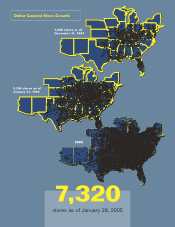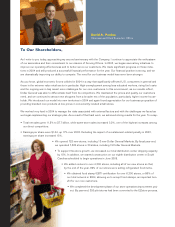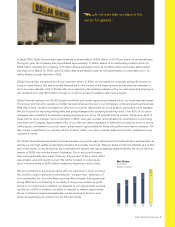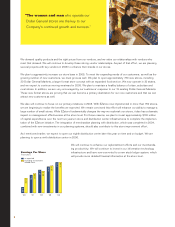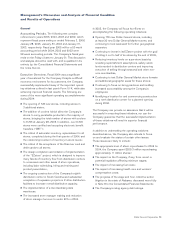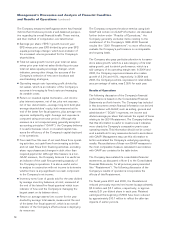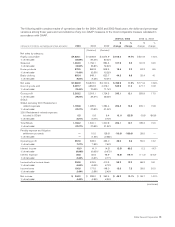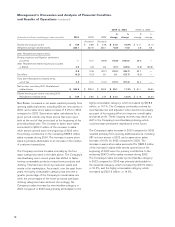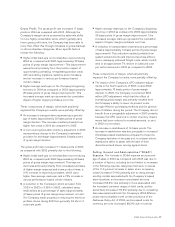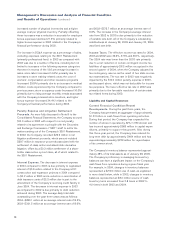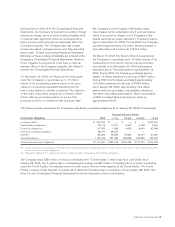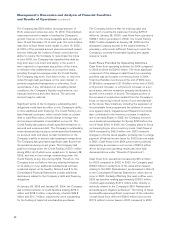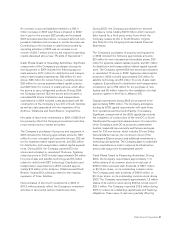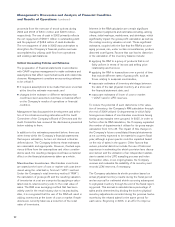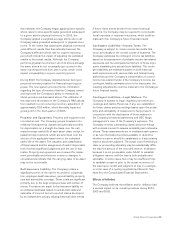Dollar General 2004 Annual Report Download - page 15
Download and view the complete annual report
Please find page 15 of the 2004 Dollar General annual report below. You can navigate through the pages in the report by either clicking on the pages listed below, or by using the keyword search tool below to find specific information within the annual report.Dollar General Corporation 13
Management’s Discussion and Analysis of Financial Condition
and Results of Operations
General
Accounting Periods. The following text contains
references to years 2005, 2004, 2003 and 2002, which
represent fiscal years ending or ended February 3, 2006,
January 28, 2005, January 30, 2004 and January 31,
2003, respectively. Fiscal year 2005 will be a 53-week
accounting period while 2004, 2003 and 2002 were
52-week accounting periods. The Company’s fiscal year
ends on the Friday closest to January 31. This discussion
and analysis should be read with, and is qualified in its
entirety by, the Consolidated Financial Statements and
the notes thereto.
Executive Overview. Fiscal 2004 was a significant
year of investment for the Company. Despite a difficult
economic environment for its customers, the Company
successfully implemented many of the important operat-
ing initiatives outlined in last year’s Form 10-K, while also
achieving improved financial results. The following are
some of the more significant operating accomplishments
during 2004:
■ The opening of 722 new stores, including stores in
3 additional states;
■ The addition of coolers (which allow the Company’s
stores to carry perishable products) in the majority of
stores, bringing the total number of stores with coolers
to 6,755 at January 28, 2005. In addition, over 6,300
stores were certified and accepting electronic benefit
transfers (“EBT”);
■ The rollout of automatic inventory replenishment to all
stores, completed during the first quarter of 2004, and
the related improvement of inventory in-stock levels;
■ The rollout of the acceptance of the Discover card and
debit cards to all stores;
■ The design completion and initiation of implementation
of the “EZstore” project, which is designed to improve
many facets of inventory flow from distribution centers
to consumers and other areas of store operations,
including labor scheduling, hiring and training and
product presentation;
■ The ongoing construction of the Company’s eighth
distribution center in South Carolina and substantial
completion of expansion projects in 2 other distribution
facilities to increase overall distribution capacity;
■ The implementation of a merchandising data
warehouse;
■ The increased store manager training and reduction
of store manager turnover to under 50% in 2004.
In 2005, the Company will focus its efforts on
accomplishing the following operating initiatives:
■ Opening 730 new Dollar General stores, including
at least 30 new Dollar General Market stores, and
continuing to look westward for further geographical
expansion;
■ Continuing to invest in its EZstore project with the goal
of rolling it out to half of its stores by the end of 2005;
■ Reducing inventory levels on a per-store basis by
revisiting replenishment assumptions, safety stock
levels needed in distribution centers and improving
execution of selling through seasonal and other non-
core merchandise;
■ Continuing to test Dollar General Market store formats
and additional geographic areas for these stores;
■ Continuing to focus on hiring practices and instilling
increased accountability among the Company’s
employees;
■ Identifying a location for and commencing construction
on a ninth distribution center for a planned opening
during 2006.
The Company can provide no assurance that it will be
successful in executing these initiatives, nor can the
Company guarantee that the successful implementation
of these initiatives will result in superior financial
performance.
In addition to undertaking the operating initiatives
described above, the Company also intends to focus
on and evaluate the status of certain other issues.
Those issues are likely to include:
■ The appropriate level of share repurchases for 2005 (in
2004, the Company spent $209.3 million repurchasing
approximately 11 million shares);
■ The impact on the Company, if any, from recent or
potential legislation affecting minimum wages;
■ The impact of increasing fuel costs;
■ The impact of increasing health care and workers’
compensation costs;
■ The progress of the wage and hour collective action
litigation in the state of Alabama, discussed more fully
in Note 8 to the Consolidated Financial Statements;
■ The Company’s rating agency debt ratings.


